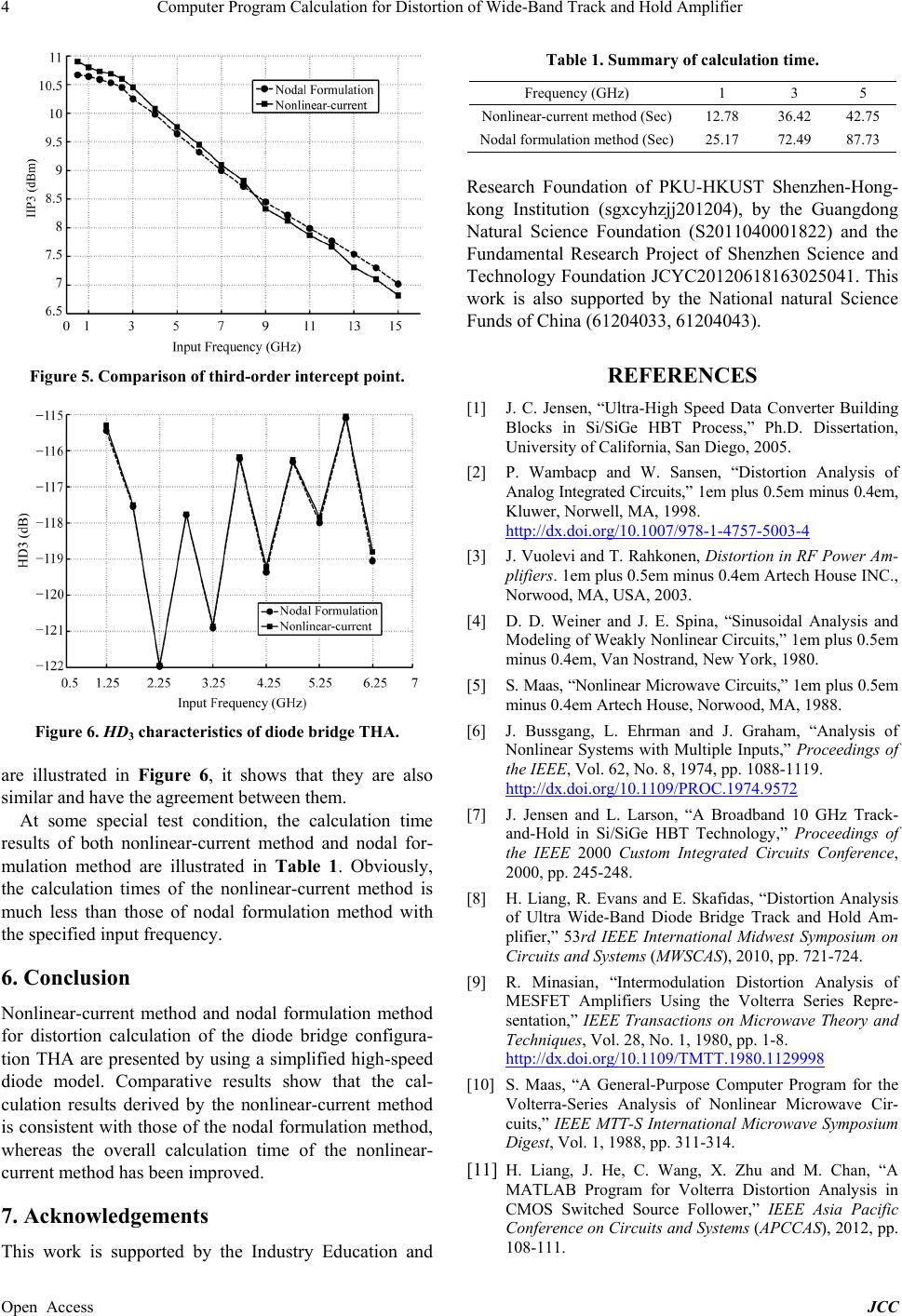
Computer Program Calculation for Distortion of Wide-Band Track and Hold Amplifier
Open Access JCC
Figure 5. Comparison of third-order inter cept point.
Figure 6. HD3 characteristics of diode bridge THA.
are illustrated in Figure 6, it shows that they are also
similar and have the agreement between them.
At some special test condition, the calculation time
results of both nonlinear-current method and nodal for-
mulation method are illustrated in Table 1. Obviously,
the calculation times of the nonlinear-current method is
much less than those of nodal formulation method with
the specified input frequency.
6. Conclusion
Nonlinear-current method and nodal formulation method
for distortion calculation of the diode bridge configura-
tion THA are presented by using a simplified high-speed
diode model. Comparative results show that the cal-
culation results derived by the nonlinear-current method
is consistent with thos e of the nodal formulation method,
whereas the overall calculation time of the nonlinear-
current method has been improved.
7. Acknowledgements
This work is supported by the Industry Education and
Table 1. Summary of calculation time.
Frequency (GHz) 1 3 5
Nonlinear-current method (Sec) 12.78 36.42 42.75
Nodal formulation method (Sec) 25.17 72.49 87.73
Research Foundation of PKU-HKUST Shenzhen-Hong-
kong Institution (sgxcyhzjj201204), by the Guangdong
Natural Science Foundation (S2011040001822) and the
Fundamental Research Project of Shenzhen Science and
Technology Foundation JCYC20120618163025041 . This
work is also supported by the National natural Science
Funds of China (61204033, 61204043).
REFERENCES
[1] J. C. Jensen, “Ultra-High Speed Data Converter Building
Blocks in Si/SiGe HBT Process,” Ph.D. Dissertation,
University of California, San Diego, 2005.
[2] P. Wambacp and W. Sansen, “Distortion Analysis of
Analog Integrated Circui ts,” 1em plus 0.5em minus 0.4em,
Kluwer, Norwell, MA, 1998.
http://dx.doi.org/10.1007/978-1-4757-5003-4
[3] J. Vuolevi and T. Rahkonen, Distortion in RF Power Am-
plifiers. 1em plus 0.5em minus 0.4em Artech House INC.,
Norwood, MA, USA, 2003.
[4] D. D. Weiner and J. E. Spina, “Sinusoidal Analysis and
Modeling of Weakly Nonlinear Circuits,” 1em plus 0.5em
minus 0.4em, Van Nostrand, New York, 1980.
[5] S. Maas, “Nonlinear Microwave Circuits,” 1em pl us 0.5em
minus 0.4em Artech House, Norwood, MA, 1988.
[6] J. Bussgang, L. Ehrman and J. Graham, “Analysis of
Nonlinear Systems with Multiple Inputs,” Proceedings of
the IEEE, Vol. 62, No. 8, 1974, pp. 1088-1119.
http://dx.doi.org/10.1109/PROC.1974.9572
[7] J. Jensen and L. Larson, “A Broadband 10 GHz Track-
and-Hold in Si/SiGe HBT Technology,” Proceedings of
the IEEE 2000 Custom Integrated Circuits Conference,
2000, pp. 245-248.
[8] H. Liang, R. Evans and E. Skafidas, “Distortion Analysis
of Ultra Wide-Band Diode Bridge Track and Hold Am-
plifier,” 53rd IEEE International Midwest Symposium on
Circuits and Systems (MWSCAS), 2010, pp. 721-724.
[9] R. Minasian, “Intermodulation Distortion Analysis of
MESFET Amplifiers Using the Volterra Series Repre-
sentation,” IEEE Transactions on Microwave Theory and
Techniques, Vol. 28, No. 1, 1980, pp. 1-8.
http://dx.doi.org/10.1109/TMTT.1980.1129998
[10] S. Maas, “A General-Purpose Computer Program for the
Volterra-Series Analysis of Nonlinear Microwave Cir-
cuits,” IEEE MTT-S International Microwave Symposium
Digest, Vol. 1, 1988, pp. 311-314.
[11] H. Liang, J. He, C. Wang, X. Zhu and M. Chan, “A
MATLAB Program for Volterra Distortion Analysis in
CMOS Switched Source Follower,” IEEE Asia Pacific
Conference on Circuits and Sy stems (APCCAS), 2012, pp.
108-111.